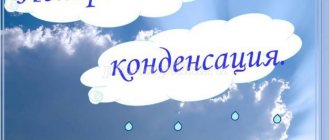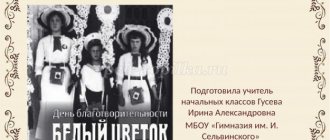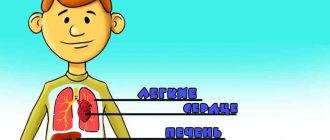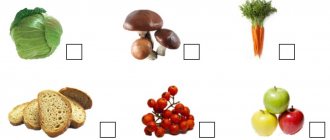Lesson topic: Convection. 8th grade
Kuznetsova Galina Nikolaevna
Lesson objectives:
- Educational: introduce the concept of “convection”, find out the reasons for its occurrence; study examples of convection manifestations in nature.
- Developmental: develop the ability to think, draw conclusions, apply knowledge, emphasize the relationship with other sciences, geography, literature.
- Educational: Develop a culture of communication, create a desire to constantly expand your knowledge; maintain interest in the subject.
Equipment: Candle, piece of cotton wool, paper pinwheel, metal rod, training scales.
Teaching aids: computer with multimedia projector, lesson presentation, electronic educational manual Physics for grades 7-11. Library of visual aids, test cards.
During the classes.
1.Organization of the beginning of the lesson (psychological mood of students).
2.Repetition of the studied material / slide No. 2/
Fill in the blanks in the text.
1.Double frames protect against cold because there is air between them. has……….. thermal conductivity.
2. To prevent fruit trees from freezing, their trunk circles are covered with sawdust for the winter. Sawdust has…….. thermal conductivity.
3. At the same temperature, metal objects feel colder than others to the touch. This is explained by the fact that metals have …………. thermal conductivity.
4. To prevent the iron handle from heating up, it is made of plastic. Plastic has……. thermal conductivity.
5.Paper, straw, air, moss, felt, cloth, linen have……. thermal conductivity.
6. Copper, lead, aluminum, steel, silver have…….thermal conductivity.
7. Experienced housewives prefer to fry in cast iron frying pans rather than aluminum ones, since cast iron has ...... thermal conductivity.
8. An aluminum cup of tea burns your lips, but a porcelain cup does not. This is explained by the fact that porcelain has…..thermal conductivity.
Words to insert: bad, good.
(test task, students complete the task and check the correctness of the answers recorded on the slide)
3. Studying new material.
Problem experiment.
/slide No. 11/
“Knowledge is the daughter of experience”, “The interpreter of nature is experience. He never deceives" Leonardo da Vinci.
Experience No. 1.
Hold your palm over the candle flame at a sufficiently distant distance. How do you feel?
Experience No. 2.
Take a piece of cotton wool, fluff it up and throw it over a burning candle. Why does the fluff not burn, but quickly rise up?
Experience No. 3.
Place the spinner on a pointed metal rod. Bring a lit candle from below. Why does the snake start to rotate?
Experience No. 4.
Take a glass flask with water, place a crystal of the coloring substance at the bottom and put it on fire. How to explain the observed phenomenon?
Experience No. 5.
Take the training scale, attach it to the tripod leg and balance it. Bring a burning match from below to a distance of 10-12 cm. Why do the scales get out of balance?
(Introduction of the concept of convection)
/slide No. 12/ hyperlink slide No. 13,14,15
/slide No. 16/
Discussion of issues.
1.Why are liquids and gases heated from below?
/slide No. 17/ /slide No. 18 video fragment/
2. Why are heating radiators usually placed below the windows, and air conditioners at the top?
/slide No. 19/ /slide No. 20 video fragment/
3. Why is it impossible to transfer energy by convection in solids? / slide No. 21 /
4. Why does convection not occur when a liquid is heated from above?
/slide No. 22/ /slide No. 23 video/
5. Convection in nature
- in the atmosphere, in the ocean, stars / slide No. 24,25 / slide No. 26 video /
4. Consolidation of the studied material.
Solving quality problems
/slide No. 27/
- When does a kettle with boiling water cool down faster: when do you put it on ice or when do you put ice on the lid of the kettle?
- Why is the heating element in an electric kettle located at the bottom of the device?
- Will a candle burn in the cabin of a spaceship in a state of weightlessness?
- Why does hot tea cool faster when stirred with a spoon?
- Lesson summary.
- Homework: /slide No. 28/ 5, No. 972,974,977. If you wish, you can draw pictures on the topic you have studied or compose a fairy tale.
Literature:
1.A.V. Peryshkin “Physics 8”.
2.V.I.Lukashik. "Collection of problems in physics."
3. I.Ya. Lanina. "100 physics games"
4.I.I. Mokrova Lesson plans for physics.
Lesson plan for a physics lesson in 8th grade on the topic: Convection
Physics lesson notes for 8th grade.
Convection Author: Shatov Andrey Borisovich, p. Simonovo; Uglovsky district Educational institution: municipal government educational institution “Simonovskaya secondary school” Subject : physics Class : 8 Lesson topic: “Convection” Class characteristics : there are 9 people in the class. 6 girls and 3 boys. Relations in the team are smooth, but there is differentiation into groups. The relationship between students and teacher is friendly. There are 6 students studying at “4” and “5”. Tools that support the learning process in the classroom: computer, multimedia projector, interactive whiteboard, presentation “Convection in liquids and gases.” Basic textbook: A.V. Peryshkin. Physics. Grade 8: Textbook for general education institutions. - M.: Bustard, 2010. Purpose of the lesson: to form in schoolchildren an idea of the process of convection as one of the types of heat transfer, to reveal the mechanism of energy transfer in liquids and gases. Objectives: - educational: expand and deepen students’ knowledge on the topic “Thermal Phenomena”; to reveal and practice the concepts of “temperature”, “heat transfer”, “convection”, to help students comprehend the practical significance and usefulness of the acquired knowledge and skills; - developing to continue the formation of key skills in students that have universal significance for various types of activities - identifying a problem, making decisions, searching, analyzing and processing information; -educational to promote the development of communication skills in the process of joint activities, creating conditions for increasing interest in the material being studied through the use of information and communication technologies of learning. Lesson type: learning new material. Forms of student work: individual, frontal, pair. Structure and course of the lesson: 1. Organizational moment. Organization of the beginning of the lesson (3 minutes). Goal: preparing students for work. Organization of attention and internal readiness of students for work, ability to organize. Student activities Teacher activities Note Preparation for the lesson. Greet the teacher and listen to information about what they will do in the lesson. Greeting, checking readiness for the lesson, voices the goals and objectives of the lesson. 2. Survey of students on the material assigned for homework. Updating knowledge (8 minutes) Goal: updating knowledge, creating a motive for knowledge. Reinforce the concepts of “heat transfer” and “thermal conductivity” and their relationship with energy and temperature. Students' activities Teacher's activities Notes Answer the teacher's questions. They give examples of heat transfer by thermal conduction in the surrounding world and explain them based on previously obtained ZUN. Frontal survey. Provides motivation and evaluates students based on their preparedness. Encourages students to ask additional questions about the topic being studied. 3. Studying new educational material. Construction of the main part of the lesson (15 minutes). Goal: obtaining new knowledge about the concept of convection, types of convection in liquids and gases. To form an idea of convection as one of the types of heat transfer. Student activity Teacher activity Note Listen to the material and write down supporting terms. Find answers to problematic questions. Draw their own conclusions from demonstrations of experience. Possesses problematic questions, divides students into groups and, by presenting new material, encourages them to find answers to them. Stimulates any activity on their part. Demonstrates the experiment: heating water with potassium manganese crystals. 4. Consolidation of educational material. Consolidation of material in auditory and visual forms. (10 minutes). Goal: To develop the ability to independently draw conclusions and correlate acquired knowledge with real phenomena in the surrounding world. Students' activities Teacher's activities Note Draw their own conclusions based on the proposed slides. Summarize the lesson. With the help of presentation, students develop the ability to draw conclusions. Encourages students to systematize the acquired knowledge. 5. Homework assignment. The final stage of the lesson (4 minutes). Goal: to form in students an idea of a systematic approach to acquiring and consolidating knowledge. Explain to students the criteria for successfully completing homework. Student activity Teacher activity Note Write down homework. Gives homework. Explains the criteria for its successful implementation. Announces grades for the lesson.
We recommend watching:
Development of an extracurricular activity in physics, grade 8. Physics lesson plan. Problem solving. (8th grade. Electrostatics) Physics research paper with presentation, 8th grade Extracurricular physics activity for students in grades 8-9
Similar articles:
Summary of a physics lesson in 8th grade on the topic “Work and power of electric current”
Physics lesson summary on the topic 'Convection' (8th grade)
Lesson summary: “Convection”
Lesson objectives: introduce the concept of convection, show its practical application.
Lesson Plan
- Organizing time.
- Verification work .
- Motivation.
- Learning new material.
- Consolidation of new material.
- Reflection.
- Homework .
During the classes.
1. Organizational moment.
Students' readiness for the lesson.
2. Motivation.
We ask students to answer several questions.
- Why are water heating radiators located under windows?
- Why are heating elements in electric kettles located at the bottom and not at the top?
- Verification work
Thermal conductivity
OPTION No. 1
- Why does an aluminum travel mug with tea burn your lips, but a porcelain mug does not?
- Why do Orenburg scarves, knitted from the finest goat down fibers, protect well from the cold?
- A person does not feel cool in air at a temperature of 20 ° C, but in water he feels cold even at 25 ° C. Why?
- Why is a second frame installed on electric trains in the winter, and removed in the summer?
- What protects animals from winter frosts?
Thermal conductivity
OPTION No. 2
- Should you heat up the soup with a spoon so that you can taste it at any time?
- Why are porous materials (glass wool, foam plastic, etc.) widely used in construction?
- Will the melting process of ice cream speed up if you put it in a fur coat?
- Which shoes make your feet feel colder: loose or tight ones? What role can a wool sock play?
- At what temperature will both metal and wood feel equally hot to the touch?
- Learning new material
A beautiful experience with liquid convection.
Take a large glass jar with a wide mouth and fill it with clean, cold water. In another small (to fit through the neck of a large jar) ceramic vessel, pour very hot water tinted with ordinary paints or potassium permanganate (green paint). Closing the neck of the small vessel with your finger, lower it to the bottom of a large jar of water.
Streams of hot tinted liquid, wriggling, will begin to rise to the surface. You will observe the phenomenon of convection in a liquid, when a lighter hot liquid, mixing with cold water, rushes upward.
The teacher helps students draw the following conclusions when learning new material.
CONVECTION is the transfer of energy by jets of liquid or gas.
During convection, matter is transported in space.
The phenomenon of convection can be explained by the thermal expansion of bodies and Archimedes' law.
Convection is impossible in solids.
The intensity of convection depends on the temperature difference between the layers of liquid or gas and the state of aggregation of the substance.
Convection can be of two types: natural and forced
for example, in a lamp, for its occurrence, heating of the liquid from below is required (or in another device, cooling from above). When under the influence of fans, pumps, movement of a spoon, etc. flows of gas or liquid are transferred.
- Consolidating new material
Application of convection in everyday life and in nature.
1. Why do aspen leaves sway in calm weather?
2. Why do window panes begin to freeze from below earlier and to a greater extent than from above?
3. Why does a thin plastic film protect the plant from the night cold?
4. When is it more convenient for sailing ships to enter the harbor: during the day or at night?
5. Explain why central heating radiators are usually placed under windows (see pictures).
6. Why are holes made in the upper and lower parts of the housings of projection devices, large electric lamps, and movie cameras?
7. Why is there more draft in furnaces with high pipes than in furnaces with low pipes?
8. Why is there less draft in metal chimneys than in brick chimneys?
- Reflection
1. What is called convection?
Answer: This is a type of heat transfer in which energy is transferred by flows (or jets) of liquid or gas.
2. How does natural convection differ from forced convection?
Answer: Forced convection occurs under the influence of external influence.
3. Why are liquids and gases heated from below?
Answer: In order for liquids and gases to warm up completely.
- Homework
§ 5. Ex. 2.




